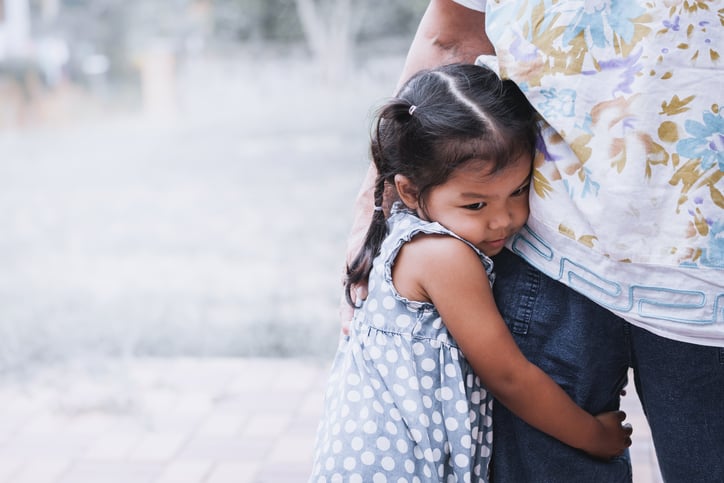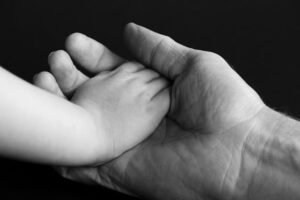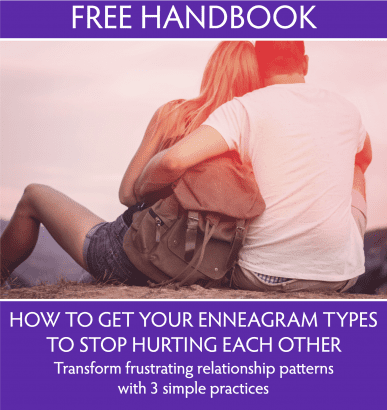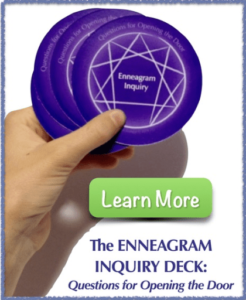Despair? It’s horrible.
Helplessness? Absolutely not. Get me out of here.
Betrayal? No way! I spend all my energy staying away from that!
Inherent in each of our personalities is a persistent approach to try to not feel upset in particular ways. We don’t want to feel alone, wrong, worthless, powerless, helpless, incapable, trapped or disconnected and our ego structures are devoted to ensuring we that don’t.
Except they fail. Regularly and consistently, they fail. All of ours do.
In fact, as we look longer and more closely at the effect that our personality “security systems” have on us, we begin to see how our enneatypes themselves can add to our suffering. And maybe that’s how it’s supposed to work so we eventually open to something more.
Coming from type Nine on the Enneagram, for example, I may be able to acknowledge over time how my habitual avoidance of conflict ends up creating even more inner and outer conflict for me. This awareness can be very useful, as I consider my situation from beyond my usual lens of type. If conflict is unavoidable in life, how do I want to engage it?
Such realizations can also stir a tendency in us to think of our enneatypes as wrong, as trouble, and in need of overthrowing. But seeing our automatic tendencies as the enemy or as something to be eradicated also adds pain and frustration. Is there no way out of this maze of human suffering?
It turns out that looking for the way “out” can be part of the problem. If I tell myself I shouldn’t be experiencing what I’m experiencing, I add another layer of angst.
So what is another way?
THE POWER OF MINDFULNESS
Mindfulness practices are wonderful in their ability to help us observe our experiences without judgment. It can be challenging and important work to simply observe and be with our tendencies, our reactions, our experiences without criticizing or evaluating them.
I have found that developing the capacities of the “inner observer” is one of the keys to transformation. When I am able to pay attention to myself in a present, open way without colluding with or rejecting the meaning I’m making of my experience, I am in a position to open to something subtly or radically new.
Often disidentifying and removing judgment is all that’s needed to create inner space and to soften the grip of our egos on our experience in the moment. This can allow in inner fresh air where I can experience other aspects of me that are independent of my usual story of myself.
But sometimes our reactivity really needs our attention and will get louder if we try to disengage from it. This can feel maddening- especially if I am meditating and practicing awareness so that I won’t have to feel these old aversive feelings anymore.
BEYOND MINDFULNESS
As it turns out, our wounds really don’t want to be bypassed. They want to be found, heard, touched and healed. And if we effectively move away from them they can feel even more despair.
The proposition of heading into the places we find intolerable, though, itself can feel overwhelming and aversive. Who wants to intentionally go toward feelings that make us feel worthless, abandoned, or violated?
Jungian analyst James Hollis, in Finding Meaning in the Second Half of Life: How to Finally, Really Grow Up, reminds us of the unavoidability of the difficult and the powerful opportunity innate in it. He writes:
“If we live long enough, we face necessary appointments with death, with loss, with betrayal, with anxiety and depression, and a host of other dismal denizens of the deep. Fate, fortune, and the autonomy of the unconscious will frequently take us to places we do not wish to visit. When we arrive in swampland zones, we are always faced with a task. That task demands of us something larger than we customarily wish to provide. We are implicitly asked: ‘How am I to enlarge consciousness in this place; how embrace life here amid peril; how find the meaning for me in this suffering?’ Identifying and accepting this task contributes to the enlargement of the soul; flight from this task perpetuates our sense of victimization and keeps us on the run from the gods and from our own larger life.”
We naturally push against difficulty. Our egos don’t want us to go to the “dreaded zone” they think they are protecting us from. They know that if we hang out there past their advice, we will start to feel into something much larger than the personality’s point of view. This feels like a bad idea if the ego want to keep us in our usual shape.
I am certainly not suggesting that we head into raw, traumatic territory recklessly or that we dive into it and act out from an overwhelmed place. This almost always make us feel worse and can also bring out the worst in others.
It’s important to know that turning toward our fear, rage or despair is not the same thing as being possessed by it. We have all had experiences when feeling deep sadness, for example. We feel utterly alone or abandoned and we believe that this aloneness and this abandonability is the truth about us. This is what I would call being “possessed” by sadness. It feels like the only real truth about us is the wound, the sense of deficiency.
 Richard Schwartz, the founder of Internal Family Systems therapy, calls this experience “blending” with our little-s self. When this happens it is almost inevitable that we will forget about our capital-S Self, the enduring aspect of us who is much more capable and resourced than the part experiencing the distress.
Richard Schwartz, the founder of Internal Family Systems therapy, calls this experience “blending” with our little-s self. When this happens it is almost inevitable that we will forget about our capital-S Self, the enduring aspect of us who is much more capable and resourced than the part experiencing the distress.
What if we stopped condemning ourselves for having “little self” moments and saw them instead as a call to our deeper nature, our larger presence?
The mythologist Joseph Campbell described the possibility and power of this kind of shift when he wrote:
“We’re in a free fall into future. We don’t know where we’re going. Things are changing so fast. And always when you’re going through a long tunnel, anxiety comes along. But all you have to do to transform your hell into a paradise is to turn your fall into a voluntary act. It’s a very interesting shift of perspective . . . Joyfully participate in the sorrows of the world and everything changes.”
I believe the “voluntary act” Campbell refers to depends our access to this larger presence in us. Choosing to be with what is happening actually calls up this capacity. Without it, we feel subjected to life. With it, we can be present with things we couldn’t have imagined.
BEFRIENDING REACTIVITY
The switch from hating our suffering to being open to respond to it can be stunning.
Have you ever witnessed a parent treating a child in a way that feels horrible in your body?  The other day at a park I heard a mother scolding her maybe four-year-old son for crying when he scraped his knee and called to her. My heart sank for the boy, for the mother, and for the way I can do that inner-scolding to myself. Seeing it externally, it was clear to me that the mother’s response did not fit what was needed in the situation. I could see that the little boy was startled, in pain, and wanted comfort. When I’m in pain internally and then I berate myself for feeling that way, the possibility of turning toward myself with love feels further out of reach.
The other day at a park I heard a mother scolding her maybe four-year-old son for crying when he scraped his knee and called to her. My heart sank for the boy, for the mother, and for the way I can do that inner-scolding to myself. Seeing it externally, it was clear to me that the mother’s response did not fit what was needed in the situation. I could see that the little boy was startled, in pain, and wanted comfort. When I’m in pain internally and then I berate myself for feeling that way, the possibility of turning toward myself with love feels further out of reach.
During the first several years that I knew the Enneagram, I found it powerful and liberating to repeatedly see my pattern at work and take it and its interpretations all less seriously. But underneath I had a neutral-to-negative attitude toward my reactivity. I wanted to reduce my feelings of inadequacy, disconnection, and worthlessness. I wanted more space from them. The Enneagram and the practice of observing my pattern in a matter-of-fact way helped me get that space. But my approach was missing some heart.
When Enneagram teacher David Daniels shared with me the notion of “befriending our reactivity” and forgiving ourselves for having the same patterns arise yet again, it helped me open my heart toward myself in this ongoing relationship with my enneatype and its fears.
I think the years of self-observation and disidentification with my type have actually helped develop my capacity to turn toward myself in a way that didn’t swamp me. I had a lifeline to a sense that I was more than my ego told me I was. This made the next moves more possible.
STEADY, PATIENT LOVE
In The Places That Scare You: A Guide to Fearlessness in Difficult Times, Pema Chödrön writes “Transformation occurs only when we remember, breath by breath, year after year, to move toward our emotional distress without condemning or justifying our experience.”
Her words “breath by breath, year after year” are worth attending to. As much as we’d like a moment of enlightenment or a great “a-ha!” to do the work for us, it might not actually satisfy us. The opportunity we have to live this loving stance toward ourselves moment-to-moment is just the medicine our deep wounds crave. The little child in us wants more than one instance of care and reassurance to change the inner game we’ve been rehearsing thousands of times prior. Time and repetition help us feel this loving stance as more deep and trustworthy over time, allowing our bodies and psyches to relax and be more present.
While our egos can be impatient, Chödrön reminds us that “Interrupting our destructive habits and awakening our heart is the work of a lifetime.” But lest you feel discouraged, I would testify that this “work” can in itself be nourishing and satisfying even when we will have to repeat it tomorrow and the next day. Our souls don’t get tired of kindness and presence. In each moment that we don’t turn away from ourselves, we get more of what we were longing for. It doesn’t actually seem like there should be a short-cut for that.
And it can be thrilling. It takes tremendous courage to enter territory that voices inside and out have been desperately warning us away from for most of our lives. My next post will address the cultivation of this courage to help us transform our troubles into “voluntary acts” of self-reclamation. Stay tuned.
(EDGY) PRACTICE OPPORTUNITIES
Which of the following attention practices might you be up for? If some seem aversive to you, it could be interesting to investigate what seems so scary about them.
- When you notice the inner command to avoid a certain feeling or experience, see whether you can pause and breathe and wait. Getting a little more space in this moment might allow you to check out what exactly is to be avoided and whether you actually agree with the command.
- When you encounter your reactivity in the moment, see whether you can shift into being there for it, curious about its beliefs and needs. How does this way of receiving your inner upset feel? How is it different than your reflexive way of responding to inner upset?
- Listen for deep parts of you who are scared, lonely, enraged or otherwise upset. Don’t dive into “being” them, but see whether you can acknowledge and bring them into the light a bit. Can you open your heart toward yourself in this experience?
I’d love to hear about your learnings as you explore a new relationship with your inner trouble. Please share in the comments below.










9 Responses
Thank you for this!
Glad it was of use!
Thank you, Sarah. I especially found these words helpful: “Our souls don’t get tired of kindness and presence. In each moment that we don’t turn away from ourselves, we get more of what we were longing for.”
Thanks for sharing what touched you, Patricia. It is so easy to forget the kindness when we’re looking at aspects that can feel like trouble.
Great stuff, helpful!!
This is a strong and subtle direction into being fully human , thank you !
Thanks for your comment Andrea. That’s a great way of putting what is possible in this approach.
I often say to clients, if someone came up and told you that your arm had a big gash on it and it was bleeding, would you say “Hey thanks,” then ignore it and go about your day? Would you not feel some desire to look down or even a sense that maybe you should stop it from continuing to bleed? We treat our inner pain/wounds like they are passable injuries that need no tending to or care.
When we stop, kneel down and take a good look at a scrape and get out the salve and bandages there is an explosion of love for others and love for self. We are committing, in the moment, to an awareness that all things heal. All things can become whole again. And let’s face it, wounds that heal well sometimes make the coolest scars, and thus, the best stories.
In the end, it seems, that kissing our boo boos really is the right path. Great piece.
Thanks for this adept metaphor Noelle. I love your naming the “explosion of love.”
To me the trickiest part is the slippery territory where it seems like if I feel the pain, I’ll become it- when there isn’t the sense of the one in me who can kiss the boo boo. This happens to all of us with the deeper wounds because that’s how they felt initially. And, thank goodness, with love and practice, this can change. Acknowledging how terrifying those moments can be can create some space to allow someone/something to kneel down and tend to us.